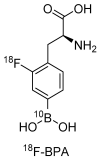Theranostics in Boron Neutron Capture Therapy
- PMID: 33920126
- PMCID: PMC8070338
- DOI: 10.3390/life11040330
Theranostics in Boron Neutron Capture Therapy
Abstract
Boron neutron capture therapy (BNCT) has the potential to specifically destroy tumor cells without damaging the tissues infiltrated by the tumor. BNCT is a binary treatment method based on the combination of two agents that have no effect when applied individually: 10B and thermal neutrons. Exclusively, the combination of both produces an effect, whose extent depends on the amount of 10B in the tumor but also on the organs at risk. It is not yet possible to determine the 10B concentration in a specific tissue using non-invasive methods. At present, it is only possible to measure the 10B concentration in blood and to estimate the boron concentration in tissues based on the assumption that there is a fixed uptake of 10B from the blood into tissues. On this imprecise assumption, BNCT can hardly be developed further. A therapeutic approach, combining the boron carrier for therapeutic purposes with an imaging tool, might allow us to determine the 10B concentration in a specific tissue using a non-invasive method. This review provides an overview of the current clinical protocols and preclinical experiments and results on how innovative drug development for boron delivery systems can also incorporate concurrent imaging. The last section focuses on the importance of proteomics for further optimization of BNCT, a highly precise and personalized therapeutic approach.
Keywords: BNCT; BPA; BSH; PET; cell-penetrating peptides CPP; image registration; proteomics; quantitative MRI; radiation oncology; small molecules.
Conflict of interest statement
The authors declare no conflict of interest.
Figures










References
-
- Sauerwein W.A.G. Neutron Capture Therapy: Principles and Applications. Springer; Berlin/Heidelberg, Germany: 2012. Principles and roots of neutron capture therapy; pp. 1–16.
-
- Sauerwein W., Bet P., Wittig A. Drugs for BNCT: BSH and BPA. In: Sauerwein W., Wittig A., Moss R., Nakagawa Y., editors. Neutron Capture Therapy. Principles and Application. Springer; Berlin/Heidelberg, Germany: 2012. pp. 117–160.
-
- Snyder H.R., Reedy A.J., Lennarj W.J. Synthesis of aromatic boronic acids. Aldehyde boronic acids and a boronic acid analog of tyrosine. J. Am. Chem. Soc. 1958;80:835–838. doi: 10.1021/ja01537a021. - DOI
Publication types
LinkOut - more resources
Full Text Sources
Other Literature Sources

